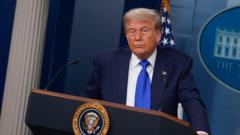The article explores how the solar panels, once seen as a symbol of energy independence under President Carter, faced removal during Reagan's presidency but continued to live on across various institutions.
Solar Legacy: The Journey of Jimmy Carter's White House Solar Panels

Solar Legacy: The Journey of Jimmy Carter's White House Solar Panels
In 1979, President Carter installed groundbreaking solar panels on the White House, and their journey after removal reflects the ongoing transition toward sustainable energy.
During a pivotal moment in American history, President Jimmy Carter made a significant move towards energy independence by installing 32 solar panels on the roof of the White House in 1979. This initiative followed the fuel crisis sparked by an oil embargo from Arab nations in 1973, highlighting America's vulnerability due to foreign oil dependence. At the dedication ceremony, President Carter proclaimed, “No one can ever embargo the sun or interrupt its delivery to us,” emphasizing renewable energy's importance long before climate change dominated political discussions.
However, in 1986, during repairs on the White House roof under President Ronald Reagan, these solar panels were removed and ultimately not reinstalled. Fortunately, their story did not end there. A small college in Maine acquired the panels at a bargain price, allowing them to produce renewable energy for years. Over time, they found new homes across various locations in the United States and even extended their reach as far as China.
Reflecting on this history, Ernest Moniz, former energy secretary under President Obama, remarked that Carter was “well ahead of his time.” The removal and relocation of these panels serve as a testament to their enduring legacy, symbolizing not only a commitment to clean energy but also the continuing evolution of the sustainable movement in America and around the world.
However, in 1986, during repairs on the White House roof under President Ronald Reagan, these solar panels were removed and ultimately not reinstalled. Fortunately, their story did not end there. A small college in Maine acquired the panels at a bargain price, allowing them to produce renewable energy for years. Over time, they found new homes across various locations in the United States and even extended their reach as far as China.
Reflecting on this history, Ernest Moniz, former energy secretary under President Obama, remarked that Carter was “well ahead of his time.” The removal and relocation of these panels serve as a testament to their enduring legacy, symbolizing not only a commitment to clean energy but also the continuing evolution of the sustainable movement in America and around the world.





















